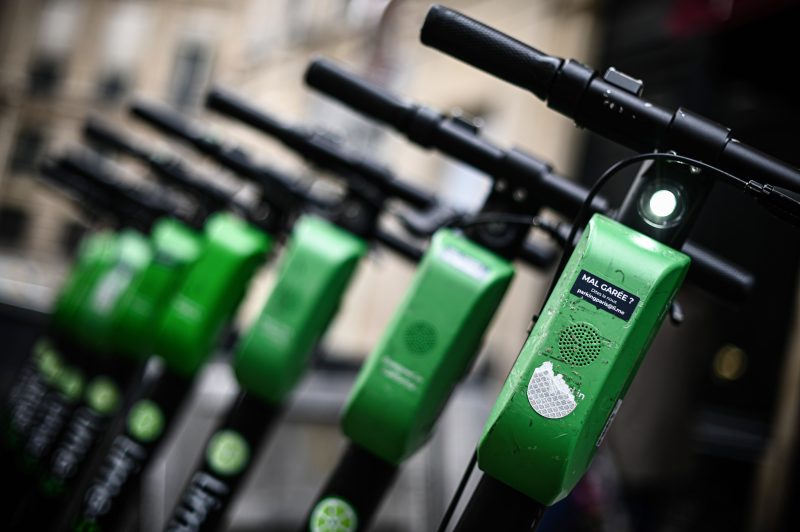E-scooters: a transport ‘tsunami’ flooding cities worldwide
Electric scooters first hit the streets of Paris in June 2018 and now there are an estimated 20,000 of them across the city (Philippe LOPEZ)
Paris (AFP) – They appeared in June last year as Paris was waking up from its annual all-night Festival of Music: hundreds of green-and-black electric scooters dotting the pavements of the capital.
The timing was perfect, with the city struggling with a botched revamp of its main bike-sharing service that left countless frustrated users looking for a new form of transport.
Cheap, widely available and easily unlocked with a smartphone app, e-scooters checked all the boxes, becoming wildly popular overnight.
“It’s happened very quickly and a bit of an anarchic way,” admitted French Transport Minister Elisabeth Borne in May. “It’s effectively been the law of the jungle.”
Over the course of a year, a total of 13 operators piled into the Paris market, putting 20,000 scooters on the streets in a chaotic free-for-all that left legislators at a loss in a country normally known for its rigorous rules and regulations.
The backlash wasn’t long coming — pedestrians terrorised by silent riders speeding down pavements, randomly-parked scooters cluttering curbs and the city’s historic squares, and a growing number of accidents.
This practical and fun form of transport, seen from Boston to Bangkok, has posed major regulatory problems, with city officials worldwide taking different approaches, from laissez-faire in Paris to a virtual blanket ban in London.
– Transportation tsunami –
Electric scooters were first launched in California in September 2017 by a startup called Bird, followed eight months later by competitor Lime.
By half-way through 2018, they had both hit Europe, moving swiftly on into the Middle East, Asia and Latin America.
Today, Bird and Lime are the largest shared-scooter operators in the world.
“Any city in the world that has been working on its transportation policy, even 18 months ago, wasn’t anticipating this tsunami,” said Joel Hazan, a partner at the Boston Consulting Group.
“It has been the fastest rollout in the history of mobility services and the quickest wave to spread across the world. It’s basically gone global over the past two years.”
For cities, the main headache is safety, but experts say that can only be addressed with a rethink of urban planning.
Elderly people knocked flying, pedestrians with broken bones, riders killed in a crash — though the horror stories exist, there is “no reliable data on collisions”, a European Transport Safety Council (ETSC) says.
Nippy and speedy, scooters zip along at up to 25 kilometres an hour (15 miles an hour), making them too fast for the pavement but problematic on roads.
Most cities would like to allow e-scooters on bike lanes, but that space often doesn’t exist.
“Cities are designed for car usage and the new question we face is how do we split the space that we’ve been dedicating to cars to create more space for pedestrians, for bikes and e-scooters,” says BCG’s Hazan.
“Security will only work if we can segregate the space,” he said.
– ‘Geofenced’ parking –
Space is also a problem with issues like parking, said Philippe Crist, an advisor to the International Transport Forum at the Organisation for Economic Cooperation and Development (OECD).
“A tremendous amount of the city is devoted to on-street parking, and if there is clutter on the pavement, it’s because there is very little space elsewhere,” he said.
Cities are now re-allocating on-street parking space to bikes and scooters, he said.
“It doesn’t actually require much — some have just started painting lines on pavements” as designated parking bays, he said, while others are experimenting with GPS technology to keep parking to a designated area.
Known as “geofencing”, it can stop a user logging off and finishing a ride if left in the wrong place.
“If not left in the right place, the operator can charge an extra fee or not allow the trip to finish, so it will keep (charging the user) until it’s in that area,” he said.
Another innovation automatically throttles down the speed within a designated zone, he said.
– Ban to plan –
Not everyone has jumped on the bandwagon, with London the only major city in Europe where e-scooters are banned unless a rider has a driving licence, insurance, road tax, a helmet and a number plate.
Although new regulations are under consideration, for the moment the law is strictly enforced.
Last year, a 15-year-old boy got six points on his future driving licence after being caught on a scooter riding at high speed.
“The best policymakers in the world are banning e-scooters, not forever, just to launch it in an organised, controlled and efficient way that is synchronised with the rest of the transportation modes,” said BCG’s Hazan.
Singapore is one such example, where new laws came into force on July 1 following a pilot involving three local start-ups.
Now only the 85,000 registered e-scooters with a licence plate are allowed on the city’s bike paths, with offenders facing a fine of 1,500 US dollars (1,300 euros) or three months in jail.
There is a 10 kilometres-per-hour (six miles-per-hour) speed limit, which is carefully monitored by officers with speed guns, and members of the public are urged to report any speeding or reckless riding.
Using GPS tracking, riders are fined for parking illegally and the city offers a Safe Riding programme.
“Cities are trying to impose much more rigorous standards on how they are deployed and what information is required from them,” said Crist, pointing to the rapid turnaround in Paris.
In recent months, the city banned riding and parking on pavements, and has imposed a code of conduct under which operators will eventually have to geofence parking spots and enforce automatic speed curbs.
Five or six of the city’s 13 fleet operators have pulled out in the past week, Crist said.
burs-hmw/adp/rma
Disclaimer: Validity of the above story is for 7 Days from original date of publishing. Source: AFP.


